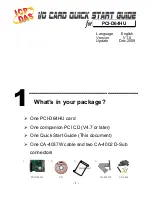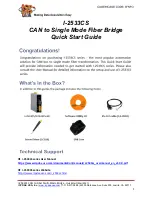
Section 3. Understanding How the SDM-SIO4 Handles Data
3-4
•
e[ ]
Scan until any ASCII character
not
entered between the brackets is
encountered. The maximum number of non-trigger characters is 255. Note
that this filter does not remove the non-matching character from the buffer.
•
F
A floating point number should be at this position. If it is found, the
signed floating point number is sent to the datalogger and removed from the
buffer. If no floating point number is found, the SDM-SIO4 sends -99999 to
the datalogger.
•
f
Search for a floating point number indefinitely, skipping any non-
numeric characters.
•
gn
Error detection – start of signature calculation for received data – see
Section 6.
•
Gn
Error detection – marks end of signature calculation for received data
– see Section 6.
•
i[ ]
Scan until any ASCII characters entered between the brackets are
encountered. The maximum number of characters between the brackets is
255. Note that this filter does not remove the matched character from the
buffer.
•
Jx:y ‘
J’ deals with signed and unsigned integers,
‘x’ is the number of characters or digits per integer (1 to 255) and y is the
number of repetitions (1 to 255).
Leading spaces and the signs ‘+’ and ‘-’ are allowed before the number but
any integer which contains non-numeric characters (e.g. 23A5) will
produce an error and return -99999.
•
nn
Discard ‘n’ bytes. ‘n’ can be in the range of 0-255.
•
Nn
Read ‘n’ bytes. ‘n’ can be in the range of 0-255 (not converted to
Campbell Scientific floating point).
•
pn
Hexadecimal byte should be here, n=number of bytes to convert (n=1
to 3 hex pairs) to Campbell Scientific floating point.
•
Pn
Converts hexadecimal value(s) to Campbell Scientific floating point
format. n=1,2,3 number of hex. pairs to convert into value LSByte first.
•
rn
Send the byte received to port ‘n’ for re-transmission. ‘n’ can be
1-4. The byte is removed from the receive buffer.
•
s
Stop the filter until commanded by the datalogger to restart.
•
t[ ]
Search for an exact string match between the [ ]. All ASCII characters
up to and including the matching string are removed from the receive buffer
before the next filter type starts.
•
T
[ ] Search for an exact string match between the [ ]. All ASCII characters
up to the matching string are removed from the receive buffer before the
next filter type starts. (Same as
t
[ ], except matching strings are not
removed).
•
u[ ]
Convert ASCII floating point into Campbell Scientific floating point
format until the termination character/string between [ ] is seen. The
termination character is removed from the buffer.
Содержание SDM-SIO4
Страница 6: ...SDM SIO4 Table of Contents iv This is a blank page ...
Страница 12: ...Section 1 Introduction 1 6 This is a blank page ...
Страница 16: ...Section 2 Installation and Hardware Set Up 2 4 This is a blank page ...
Страница 26: ...Section 3 Understanding How the SDM SIO4 Handles Data 3 10 This is a blank page ...
Страница 32: ...Section 4 Programming the SDM SIO4 4 6 This is a blank page ...
Страница 62: ...Section 5 Programming the Datalogger 5 30 This is a blank page ...
Страница 76: ...This is a blank page ...
Страница 81: ...This is a blank page ...
















































